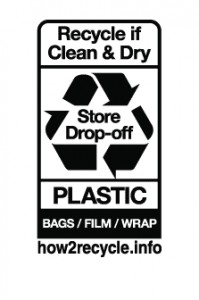An idea. I’m brainstorming here.
 The plastic bag industry definitely has gotten the memo loud and clear about recycling plastic bags. However, the plastic bag recycling industry wants clean dry thin filmed plastic bags for recycling, not soiled ones. That means they want plastic bags to be returned to participating stores. Neither the plastic industry or the City of Newburyport wants them in the recycling bins (plastic bags reek havoc for our recycling machines). The thin film plastic bags and other clean, dry thin film products are then bailed and shipped to places in the United States or to Canada or China for recycling. Recycling thin clean, dry thin film plastic is a billion dollar business, for real (see earlier entry).
The plastic bag industry definitely has gotten the memo loud and clear about recycling plastic bags. However, the plastic bag recycling industry wants clean dry thin filmed plastic bags for recycling, not soiled ones. That means they want plastic bags to be returned to participating stores. Neither the plastic industry or the City of Newburyport wants them in the recycling bins (plastic bags reek havoc for our recycling machines). The thin film plastic bags and other clean, dry thin film products are then bailed and shipped to places in the United States or to Canada or China for recycling. Recycling thin clean, dry thin film plastic is a billion dollar business, for real (see earlier entry).
So this might be a way to have small stores to be able to recycle plastic bags, if that is what they would like to do. Maybe the stores downtown, on Storey Avenue and in the Tannery might be able to participate (if they wanted to, along with providing reusable bags and bags made out of paper, I’ve seen some really nice ones from stores downtown). And maybe either Market Basket or Shaw’s might be able to be the “anchor store” (see below).
If the “industry” is involved, (the “bad guys”) in helping the city with a plastic bag recycling program, then the plastic bag industry has a real incentive to not only help us start something effective, but make sure that each year it becomes more and more successful.
So this is a quote from PlasticFilmRecycling.org on a “Business-to-Business” (B2B) pilot program. And the website may look like a non-profit, but the American Chemistry Council is behind it (see the fine print at the bottom). So yes, I am proposing that environmentalist work with “the bad guys” to come up with a solution instead of an outright ban on plastic bags. Nelson Mandela knew about working with your enemy–he becomes your partner.
This is from “Business-to-Business” (B2B), the entire link can be read here.
“The B2B recycling program staff facilitated partnerships with large retail “anchor” stores and their smaller neighbor merchants that are located in shopping centers and malls. The anchor stores serve as collection points for clean, used plastic bags and film from their customers and from the neighboring stores. The anchor store is then able to use its existing infrastructure to transfer or “backhaul” the plastic bags and film back centers in delivery trucks that would otherwise return empty to their distribution centers.
The smaller retailers benefit because they are able to take advantage of a recycling opportunity that in most cases would be too expensive or unavailable to them. The anchor store benefits by being able to sell more recyclable material and to promote its environmental efforts by using existing resources and committing to a relatively small increase in labor. The Orange County SWMD benefits in many ways including conservation of landfill space due avoided disposal of tons of plastic bags and film, increased recycling rates, and avoided costs for a commercial recycling program as a result of the successes of the B2B recycling program.”
And to learn about Marine Debris, visit NOAA’s (U.S Department of Commerce, National Oceanic and Atmospheric Administration) Marine Debris website here, including information on what is sometimes referred to the great garbage patch, or how debris accumulates in the ocean here.
From NOAA: “Our oceans are filled with items that do not belong there. Huge amounts of consumer plastics, metals, rubber, paper, textiles, derelict fishing gear, vessels, and other lost or discarded items enter the marine environment every day, making marine debris one of the most widespread pollution problems facing the world’s oceans and waterways…” “The term “Pacific Garbage Patch” is a popular nickname for an area of marine debris concentration in the North Pacific Ocean, located in between Hawaii and California…” “While higher concentrations of litter items can be found in this area, along with other debris such as derelict fishing nets, much of the debris is small pieces of floating plastic that are not immediately evident to the naked eye…”
And from NOAA’s Marine Debris Blog, which can be read here.
“With all of this information flying around, much of it conflicting, what is actually known about these topics? And what do we believe?
First, the name “garbage patch” is a misnomer. There is no island of trash forming in the middle of the ocean, and it cannot be seen with satellite or aerial photographs. While it’s true that these areas have a higher concentration of plastic than other parts of the ocean, much of the debris found in these areas are small bits of plastic (microplastics) that are suspended throughout the water column. A comparison I like to use is that the debris is more like flecks of pepper floating throughout a bowl of soup, rather than a skim of fat that accumulates (or sits) on the surface…”
“The bottom line really is that all of this human-made trash simply does not belong in our oceans or waterways…”
All of this is not good.

